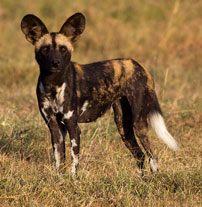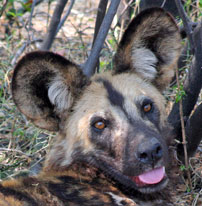Many species are ‘sought after’ by safari enthusiasts when it comes to game viewing in Africa – the elegant giraffe, the grumpy hippo, the majestic lion, the secretive leopard, the timid cheetah, the pre-historic rhino or perhaps the powerful and intelligent elephant. Some animals are easier to see than others, but one species that can quietly frustrate enthusiasts is the African wild dog, an endangered and spectacular predator which ranges great distances in large family groups and seldom sits around waiting to be photographed.
Wild dogs are making a strong  comeback across many parts of Africa, from the ranch lands of northern Kenya to the wilderness regions of southern Tanzania and eastern Zambia, through to the private reserves of South Africa. However, Botswana will always remain a natural stronghold for wild dogs, with plenty of natural prey (impala predominantly), vast wilderness regions for them to roam and little interference from mankind. On a recent trip to Botswana’s Savuti, Linyanti and Okavango Delta regions, I was able to witness first hand just how much this species is thriving.
comeback across many parts of Africa, from the ranch lands of northern Kenya to the wilderness regions of southern Tanzania and eastern Zambia, through to the private reserves of South Africa. However, Botswana will always remain a natural stronghold for wild dogs, with plenty of natural prey (impala predominantly), vast wilderness regions for them to roam and little interference from mankind. On a recent trip to Botswana’s Savuti, Linyanti and Okavango Delta regions, I was able to witness first hand just how much this species is thriving.
The Linyanti Region of Botswana has long been known as ‘wild dog country’. From the Kwando Reserve in the north, through the Selinda Reserve and Linyanti Concession to the Chobe Enclave Community Reserve and the Savuti Marsh area of Chobe National Park, several packs of wild dog roam with confidence. They don’t have designated territories as lion prides do, but they do tend to keep away from other packs of dogs. Occasionally different packs will meet, and fireworks can ensue. The day before I stayed at the lovely Savuti Camp in the Linyanti Concession, two strong packs had fought an epic battle along the Savuti Channel. The next day we witnessed one of the packs lazing nearby, close to the Linyanti River, but the other pack was nowhere to be seen.
For the most guaranteed sightings of wild dogs, it helps if you know where their den site is. Wild dogs will usually find a den site in June or July, and often re-visit old sites. Once the alpha female has given birth, the dogs are ‘tied’ to that site for several months, returning to it once or twice a day to regurgitate food for the pups, and to sleep each night (dogs hunt mostly in the early morning and late afternoon).
I was also lucky enough to see a fantastic pack of dogs in the southern section of the Okavango Delta, in the Chitabe/ Sandibe concession which borders the southern edge of the Moremi Game Reserve. The dogs, including nine puppies, were waking up from there daytime sleeping when we arrived, and we watched them stretching, playing and reaffirming their bonds before they began their main purpose for the afternoon………hunting. To witness wild dogs hunting is a rare privilege, an astonishing sight whereby the dogs begin by trotting purposefully, and then when prey is sighted and singled out (usually impala) they move up through the gears to a speed a vehicle just can’t keep up with safely! I have seen wild dogs chasing buffalo (pointless) and leopard (competition), neither of which seem to be a sensible use of energy, but energy is something they don’t seem to struggle with………once they have locked on to a particular impala prey, they run it down mercilessly, using both speed and stamina. On this occasion, the dogs did not seem committed and some lucky impalas had a narrow escape. However, this is unusual – wild dogs have the highest success rate of all African predators.
